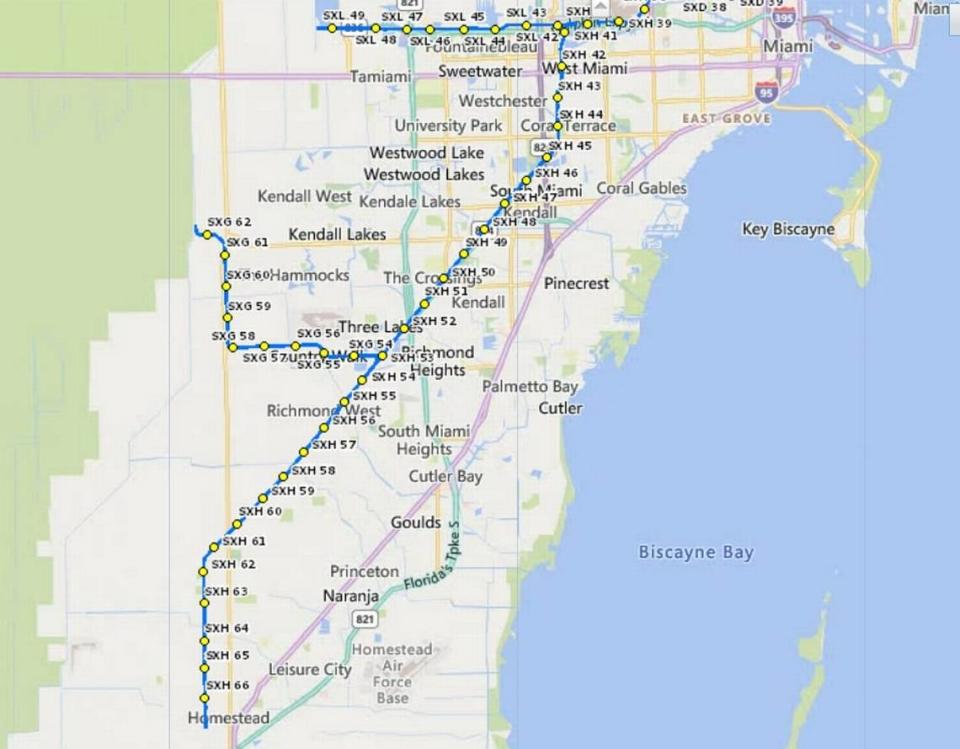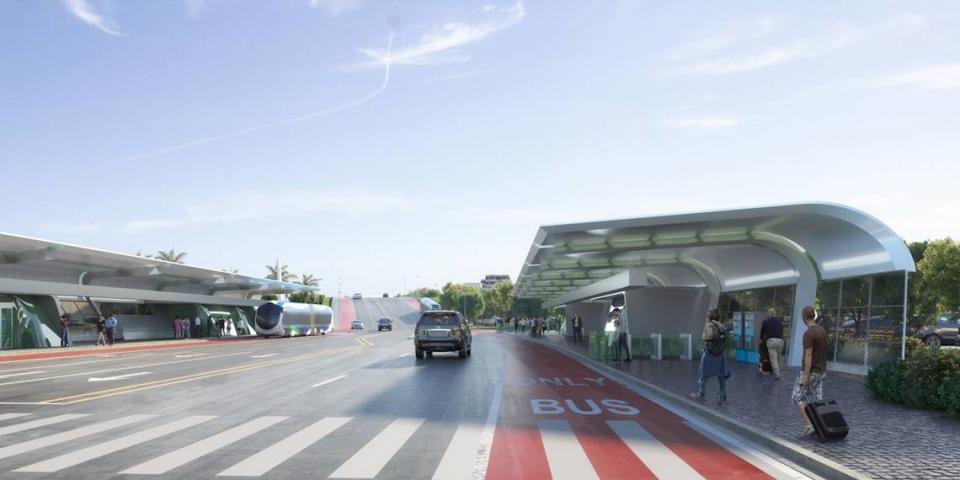Could western, southern commuters get a rail option? Miami-Dade revives 836 train idea
Commuter trains would run to Homestead, Doral and other suburbs under a revived effort to use CSX freight tracks for passenger rail, a strategy studied since the 1980s and once again a focus of transit planners.
One train line would run from Miami International Airport along the 836 expressway to the Doral area, replacing a stalled plan to build a rapid-transit bus line on the busy toll road. Another train line would run from the airport to Homestead, along CSX tracks west of U.S. 1 and the existing Metrorail and South Dade busway.
There are no agreements or price estimates for either effort, with CSX executives preparing for their first round of meetings with county officials in Miami next month.
READ MORE: A costly piece for Miami-Dade’s east-west route: CSX tracks
But the company has tapped a top executive from Brightline to help revive interest in Miami-Dade commuter trains on CSX freight tracks, a model that would replicate what Brightline has done with passenger service along tracks once used only for cargo between Miami and Orlando.
CSX representatives did not respond to requests for comment. People who have spoken to executives at the Jacksonville-based company say CSX is willing to lower its financial demands to the point that Miami-Dade could close a transit deal.
“The only issue with CSX has always been the price,” said Kionne McGhee, a Miami-Dade commissioner representing Homestead who met with CSX executives about six months ago at corporate headquarters. “Now cost may not be the issue. It’s just going to be having the political will to finally bring rail to the south.”

When Miami-Dade last considered commuter rail on the CSX tracks about eight years ago, the company wanted hundreds of millions of dollars to sell the corridors to the county. The rails are used to ship materials for rock mines in the west and farms in the south.
Leasing use of the tracks rather than buying
While CSX previously wanted to sell the tracks to Miami-Dade, McGhee said the company now is proposing the same kind of track fee that Brightline is negotiating for a new county commuter line between Miami and Aventura.
The potential cost of that fee hasn’t been made public. The fee also wouldn’t cover the regular operation and maintenance expenses that make heavy rail the most expensive of transit options.
A 2020 study by Miami-Dade’s Department of Transportation and Public Works estimated it would cost up to $1 billion to convert the CSX tracks north of 836 into a street-level commuter rail, but that included purchasing tracks from CSX.
The route along the 836, also known as the Dolphin Expressway, would have run between the airport and the Dolphin park-and-ride station in Sweetwater, along with dedicated bus lanes to connect shuttles to Florida International University through the nearby Tamiami park-and-ride complex.
READ MORE: Six ways to expand rail in Miami-Dade
Still, running a new rail line would add a new big-ticket item to Miami-Dade’s $700 million yearly transit budget.
The 2020 study estimated the train option would cost $27 million to $33 million a year to maintain and operate. Metrorail’s operating budget for 2023 is $74 million.
Fewer stops per hour
Commuter rail service means trains don’t arrive four or five times an hour during peak times as Metrorail does. Instead, commuter trains, like Tri-Rail, typically arrive every 30 minutes or so, targeting travelers looking to head to work for the day and then get home without driving the entire time.
The 2020 study said it would take about 28 minutes for a passenger to get from the Tamiami park-and-ride complex near FIU to the MIA Metrorail station, a trip that includes the bus shuttle to a rail station on CSX tracks near Doral at the Dolphin Station park-and-ride complex in Sweetwater.
In Homestead, a commuter train would mean a rail option in an area only served by county buses. Recent county studies haven’t estimated how long it would take a commuter train to travel the roughly 25 miles of CSX tracks between Homestead and MIA.

Rail’s high costs steered the county’s main transportation board away from using the CSX tracks when deciding on the best transit option for the 836 corridor in 2020.
Instead, the Transportation Planning Organization endorsed building the county’s second rapid-transit bus system (often called “BRT” for short), with dedicated lanes separated from auto traffic, rail-like stations allowing for advanced ticket sales and vehicles that let passengers board without stepping up into a regular bus.
The $400 million BRT project never advanced from the planning stage and now is being declared all but dead due to logistical issues not anticipated three years ago.
The plan calls for bus stops on 836 attached to stations and parking lots on streets below the elevated expressway, with elevators and walkways connecting the two levels.
In reviewing potential layouts for the stations, the design required to get passengers from the parking at ground level to the bus stops on the expressway’s higher elevation will involve too much walking and climbing, said Eileen Higgins, a Miami-Dade commissioner representing parts of Miami and Miami Beach and the primary backer of the original BRT plan.
“It looks outrageously impractical,” Higgins said at a meeting of the Transportation Planning Organization on Thursday. “I think we all agree we need to pivot to the CSX tracks.”
Brightline is in the conversation
At the meeting, one of the county’s most influential lobbyists, Jose Gonzalez, revealed he was working with CSX to try and land a rail deal. A senior vice president in charge of deals for Brightline parent Florida East Coast Industries, Gonzalez said the companies are teaming up in hopes of expanding revenue for both train operators along the CSX Miami tracks.
CSX could see more profits from expanding traffic on its tracks, and Brightline would have a hand in developing commercial and residential real estate around the new stations, Gonzalez said.
“We do a lot of real estate development with CSX,” Gonzalez told the transportation board.
Gonzalez said he accompanied McGhee on his trip to CSX headquarters, and that the company is now interested in seeing its Miami-area tracks used much more, both by freight and passenger trains.
“They see an opportunity for their business,” he said, “and they see an opportunity to grow.”

